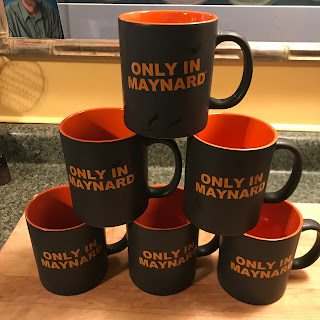Nearly 20 years ago it was possible to buy ONLY IN MAYNARD™ bumper stickers, T-shirts and sweatshirts at local stores and at Maynard Fest. The lettering was orange against a black background - Maynard's school colors. Then, for a while, the sole remnant of this endeavor was bumper stickers for sale at Russell's convenience store, next to Town Hall.
The bumper stickers had TM superscripted above the end of ONLY IN MAYNARD, signifying that an application had been filed for a trademark in 2003. This was a Massachusetts-only trademark. It lapsed, but a new Massachusetts trademark was issued in 2017 to a new holder. As of 2020 there are ONLY IN MAYNARD bumper stickers and T-shirts, offered for sale at various venues and events, with profits channeled to non-profit organizations located in Maynard.
A bit of history: In the original form and subsequent incarnations, the words on ONLY IN MAYNARD products were deliberately printed so that the right side was noticeably higher than the left. Best guess is the wording was askew to convey that negative, rueful pride that only in Maynard could things (town things, school things, people things...) be so humorously incompetent or fouled up.
To counter the prevailing negative impression, a group of civic-minded citizens approached the Beacon-Villager newspaper back in 2005, to see if they could take turns writing a pro-Maynard column featuring the friendly and welcoming nature of this unique small town. The column lasted only a few months. An echo of that positive intent was conveyed in a 2008 article in the Beacon-Villager that read in part "A clever slogan, coined some few years ago, continues to describe our singular uniqueness, our melting pot citizenry and our basic values for the 'good life.' That slogan, ‘Only in Maynard,’ sets up the town as a special place where very special people do distinctive and exceptional things. This is especially true in the art of song and music as developed in our town."
An informal survey of people about town yielded both the negative and positive connotations, and also a third meaning - the concept of specialness. Only in Maynard can you see Santa Claus arriving by helicopter for the Christmas parade. Only in Maynard can you still find a local movie theater. Only in Maynard are the bars close enough together to have a pub crawl that might involve actual crawling (or at least walking) rather than driving.
So, after all this debate, what does "Only in Maynard" really mean today? Whether it is only in this small town are people so warm, friendly and welcoming, or only here are things so ruefully, headshakingly messed up, or a comment on the unique nature of life in Maynard, my own opinion is that in comparison, ONLY IN ACTON or ONLY IN SUDBURY or ONLY IN STOW would make no sense whatsoever.
UPDATE: As of end of 2022, 550 mugs have been sold at $10 each, Starting 2023, price goes to $15 each, as purchase cost has gone up. Contribution to Trail of Flowers is approaching $2,000.


